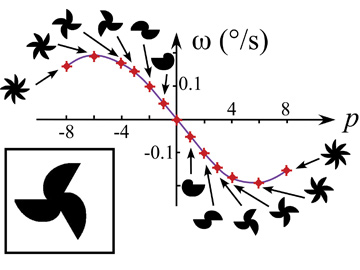 Angular rotation speed, ω, of millimeter-scale, 2-D paddles, versus number of blades, p, as rotation is induced in the paddles using ordinary light. Crosses are experimental values; solid line is a guide for the eye. Inset: paddle with three blades.
Angular rotation speed, ω, of millimeter-scale, 2-D paddles, versus number of blades, p, as rotation is induced in the paddles using ordinary light. Crosses are experimental values; solid line is a guide for the eye. Inset: paddle with three blades.
The ability to rotate micro-objects optically has potential applications in domains such as micro-electromechanical systems, biomanipulation and optofluidics.1–3 Some configurations take advantage of specially shaped, 3-D objects and the scattering of ordinary light, together with the radiation pressure force; other setups use the light’s spin angular momentum (related to circular polarization) or orbital angular momentum (OAM).
Using a totally different mechanism, we have demonstrated optically induced rotation of simple asymmetric 2-D objects, using plane waves originating either from ordinary laser sources or from blackbody radiation.3 The objects being manipulated are millimeter-scale paddles with one to eight blades, printed on an ordinary transparency. The light diffracted by the edges of such objects carries OAM which, due to the mechanical conservation of angular momentum, is transferred to the diffracting objects, resulting in rotation.4–5 A slight frequency shift of the diffracted light allows energy to be conserved.
With the objects floating on an air–water interface, we observe a steady-state rotation that varies with the light intensity and the object’s asymmetry. We have demonstrated rotation either with a relatively low-power laser source or with blackbody radiation from a 100-mW source, and have eliminated absorption and thermocapillary effects as possible causes of the rotation. The only available torque arises from diffraction by the edge of the object, plus conservation of angular momentum.
Such rotations might find ready applications in optofluidic devices that could optically drive micromotors, to generate liquid flows without the need for special absorbing, reflecting or birefringence properties in the micromotor. From another perspective, this work may shed light on the complex issue of the origins of biological homochirality—the tendency of certain biomolecules to occur only in “left-handed” or “right-handed” form. With sunlight potentially able to induce rotation in macromolecules or colloidal particles on an air–liquid interface, it is conceivable that the combination of light and rotation may lead to asymmetry in initially symmetrical objects, leading to chirality.
Researchers
Olivier Emile and Janine Emile, Université de Rennes 1, France
References
1. D.G. Grier. Nature 424, 810 (2003).
2. A. M. Yao and M. J. Padgett. Adv. Photon. 3, 161 (2011).
3. K. Kim et al. Nanoscale 8, 10471 (2016).
4. O. Emile and J. Emile. Opt. Lett. 41, 211 (2016).
5. O. Emile et al. Phys. Rev. A 89, 013846 (2014).
